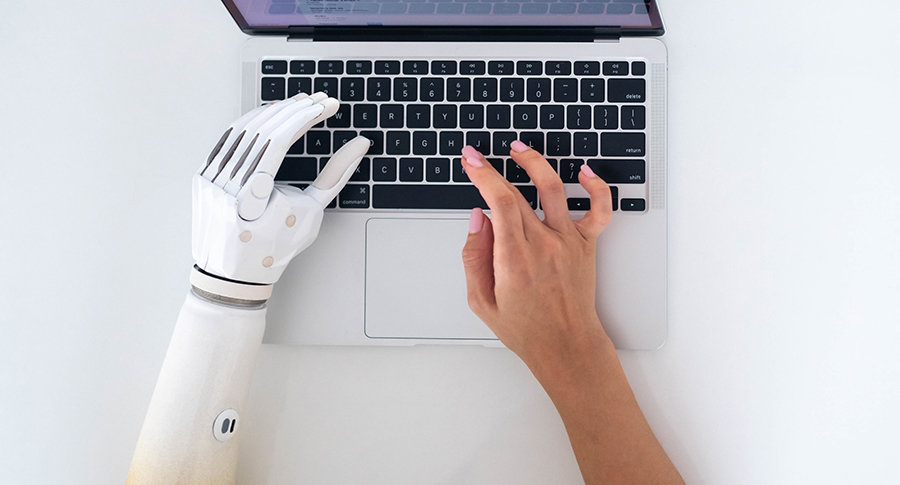Guest article: An artificial helping hand – Improving prosthetic design and manufacture with electronic drive systems

Dave Walsha, Sales Manager at DC motor supplier EMS, explains how developments in manufacturing and robotics technologies are allowing the creation of prosthetics that offer levels of comfort and functionality like never before, reducing abandonment and giving patients freedom in their daily lives.
Upper limb prosthetics are abandoned by some 18 percent of patients, though some studies cite this figure as high as almost one in two. Evidently, replicating the complexity of human design in a comfortable, easy-to-use prosthetic is no easy feat. But developments in manufacturing and robotics technologies are offering patients a prosthetic experience like never before.
Crutches, rollators, and wheelchairs offer some leg amputees additional support for movement. But these types of aids do not grant the same freedom as two working limbs, and the problem is amplified for those also missing hands or arms. Simple tasks such as opening a jar or tying a pair of shoelaces become difficult and time-consuming, leading to frustration and a decreased quality of life.
As a result, extensive efforts have been made over the years to create prosthetic limbs that grant amputees more freedom and independence.
Prosthetic principles
There are two main types of prosthetics: passive and active. Passive devices are simply for aesthetic purposes, offering no additional movement. Active or powered devices are those that provide functionality to the limb.
Electrically powered prosthetics, or ‘myoelectric’ prosthetics, contain electrodes to receive electromyographic (EMG) signals from the muscles or nerves above the amputation. It’s these electrical signals that are transmitted to the prosthetic’s control electronics, where the signals are amplified and used to direct the motors to move accordingly.
Prosthetic problems
Despite the benefits prosthetics can offer, the technology still faces problems. Poor fit is a common problem reported by users, which can lead to discomfort, skin irritation, and even causing some patients to abandon their prosthetic altogether.
The highly individualised nature of humans, whether it’s their body proportions or the nature of the amputation means that no two users are the same — and therefore, neither should their prosthetics be. This makes component manufacturing hard to standardise, while also increasing the cost per prosthetic.
Another common concern is the lack of functionality. The human hand is able to grip objects of a variety of shapes, sizes, and textures. This includes fragile items, which can be held tight enough to keep them secure but without damaging or breaking the object. Most commercially available bionic hands struggle to offer a comparable level of movement or sensory feedback and can therefore be a source of frustration more than an aid.

Improving design
These issues represent a major challenge for designers, but there are ways to address them. Tackling fit and customisation issues, for instance, is possible by making use of 3D printing technologies.
In recent years, advancements in 3D printing have made it more commercially viable to produce highly customisable products. With no minimum order or the need to create specific moulds, prosthetics can be prototyped and developed on an individual basis for an improved fit. This also allows for aesthetic personalisation for a less obtrusive prosthetic.
To address functionality concerns, miniaturisation of the electronics within the prosthetic is essential. The DC motors that facilitate the movement of artificial joints must be small enough to fit within a housing built to replicate human limbs. However, these size restrictions should not come as a detriment to the rest of the specification. It’s important that these motors still offer a high torque, with the ability to quickly change direction to account for quick or sudden movements.
Opting for a coreless or ironless DC motor is preferable for many medical applications, and prosthetics is no exception. Eliminating the iron contained in traditional DC motors significantly reduces the minimum moment of inertia, allowing for rapid acceleration and deceleration rates and cogging-free running. Additional benefits include low noise, a compact design, and low power consumption, particularly at no-load conditions.
Other considerations include the choice of commutation. Graphite and precious metal commutation types are available, though the latter is best suited to compact, battery-powered applications.
Implementing more sophisticated technology unlocks further benefits, such as prosthetics that can adapt to the individual’s gait. High-power microprocessors and miniature precision sensors working alongside these motors allows for a system that can respond in real-time to patient movement. These offer a more natural walking experience and mean that the prosthetic can react quickly in the case of a stumble or loss of footing.
The design and manufacture of prosthetics maintains a challenge, but with the continued need for artificial limbs, it’s an area that’s important to develop further. By making use of improved prototyping technologies, materials, and electronics, manufacturers can offer amputees with a prosthetic experience a touch above the rest.

